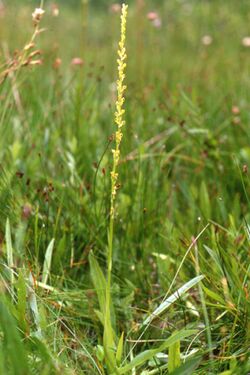Biology:Platanthera yosemitensis
From HandWiki
Short description: Species of orchid
| Yosemite bog orchid | |
|---|---|

| |
| Scientific classification | |
| Script error: No such module "Taxobox ranks".: | Plantae |
| Script error: No such module "Taxobox ranks".: | Tracheophytes |
| Script error: No such module "Taxobox ranks".: | Angiosperms |
| Script error: No such module "Taxobox ranks".: | Monocots |
| Script error: No such module "Taxobox ranks".: | Asparagales |
| Script error: No such module "Taxobox ranks".: | Orchidaceae |
| Script error: No such module "Taxobox ranks".: | Orchidoideae |
| Script error: No such module "Taxobox ranks".: | Platanthera |
| Script error: No such module "Taxobox ranks".: | <div style="display:inline" class="script error: no such module "taxobox ranks".">P. yosemitensis |
| Binomial name | |
| Platanthera yosemitensis Colwell, Sheviak and P.Moore[2]
| |
| Synonyms[3] | |
|
Limnorchis yosemitensis (Colwell, Sheviak & P.E.Moore) P.M.Br., S.L.Stewart & Gamarra | |
Platanthera yosemitensis, the Yosemite bog orchid,[4] is a species of orchid that is endemic to nine wet montane meadows between the main stem and the South Fork of the Merced River in Yosemite National Park.
First collected in 1923, it was not recognized as a distinct species until 2007. The species grows at altitudes of 1,800–2,700 m (5,900–8,900 ft). The orchid has a foul smell that has variously been described as "corral of horses, asafetida, strong cheese, human feet, sweaty clothing, or simply disagreeable".[5] The orchid's yellow flowers are less than 8 mm (1⁄4 in) wide, and are pollinated by insects.[6]
References
- ↑ "NatureServe Explorer 2.0". https://explorer.natureserve.org/Taxon/ELEMENT_GLOBAL.2.806492.
- ↑ Colwell, A. E. L., et al. (2007). A new Platanthera (Orchidaceae) from Yosemite National Park, California. Madroño 54:1 86-93.
- ↑ Kew World Checklist of Selected Plant Families
- ↑ "Platanthera yosemitensis". Natural Resources Conservation Service PLANTS Database. USDA. https://plants.usda.gov/core/profile?symbol=PLYO2. Retrieved 7 October 2015.
- ↑ United States Geological Survey (2007-07-16). "USGS Botanists Help Identify a New Orchid, the Yosemite Bog-Orchid". http://www.usgs.gov/newsroom/article.asp?ID=1706. Retrieved 2007-07-17.
- ↑ Lahondère, Chloé; Vinauger, Clément; Okubo, Ryo P.; Wolff, Gabriella H.; Chan, Jeremy K.; Akbari, Omar S.; Riffell, Jeffrey A. (2020-01-07). "The olfactory basis of orchid pollination by mosquitoes" (in en). Proceedings of the National Academy of Sciences 117 (1): 708–716. doi:10.1073/pnas.1910589117. ISSN 0027-8424. PMID 31871198.
External links
| Wikimedia Commons has media related to Platanthera yosemitensis. |
Wikidata ☰ Q7202182 entry
 |

